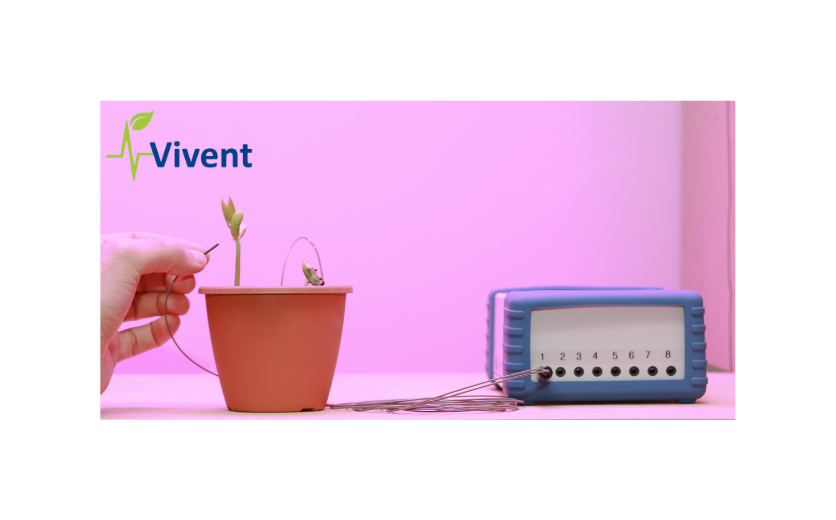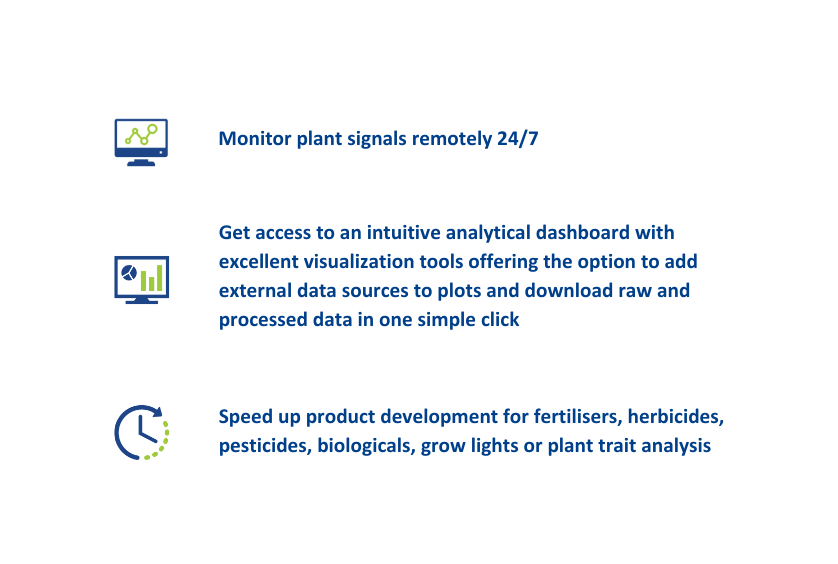
The field of plant electrophysiology has been studied for over 100 years but progress interpreting plant signals was limited. Now Vivent, other companies, and leading researchers are making major progress at decoding these signals and relating them to specific plant responses. Extracellular electrophysiology detects global plant ion fluxes in response to external stimuli, modulated by receptors and various types of ion transporters. Vivent’s biosensors are designed specifically for capturing plant electrical signals and work with both soft stemmed and woody species at different developmental stages.
Supported by cloud calculations and live data streaming, Vivent biosensors provide great tool to study plant responses to biotic and abiotic stimuli, plant development, exogenously applied substances (e.g. bio stimulants, phenotyping of mutants, and natural accessions).
Plant scientists can carry out experiments in laboratory, greenhouse, and field conditions. Scientists have access to a LiveView of their plant signals remotely so monitoring experiments can be done from anywhere. Vivent provides access to an intuitive, interactive analytics dashboard to visualize plant signals and carry out statistical and machine learning analyses.
Interactive graphs give an easy access to crucial information. The raw data can be also downloaded to investigated in more detail with algorithms created by Vivent or by the user. Vivent’s dashboard enables plant scientists to save time, money and get an access to unique information about plant responses to environment.

What is crop electrophysiology?
Plants use internal electrical, hydraulic and chemical signalling networks to coordinate growth and defence. Electrical signals are some of the fastest to spread information across the entire plant. Vivent’s technology, and artificial intelligence, lets researchers interpret this information to measure plant health, and to diagnose stressful conditions e.g. pathogens prior to visible symptoms. In response to (a)biotic stimuli the ion transporters in many individual plant cells respond simultaneously, producing an electrical change characteristic of that stimuli. Advanced signal processing isolates this characteristic in different time scales and provides an accurate diagnosis of the plant’s condition in real time.
How does it work?
Two silver electrodes are attached to a plant and its internal electrical signals are amplified and recorded. Our biosensors can monitor up to 8 plants at the same time. The electrodes typically stay in place throughout the entirety of an experiment.
In real time, signals are compared to a library of diagnostic algorithms. External climate data can also be imported onto the dashboard to be compared with plant signals.
A live view of plant electrophysiology signals shows how plants are responding to current environmental conditions and when a plant reacts to a stressor, like a change in temperature or insect infestation.This information provides valuable evidence of differences in genetic backgrounds, growing conditions or the efficacy of treatments.

Your Content Goes Here
DECODE PLANT SIGNALS IN REAL-TIME

“QUOTE”

Andrzej's background
Challenges:
Time and money
Tedious processes, lots of waiting
